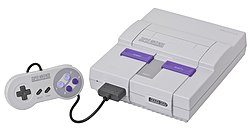Events
Notable releases
- January - The first two THQ releases came out in stores.
- February 14 – DMA Design releases Lemmings , a puzzle game that requires the player to lead a group of anthropomorphic lemmings through a dangerous environment to an escape portal.
- March – AOL, SSI, TSR and Stormfront Studios collaborate and launch Neverwinter Nights , credited as the first graphical MMORPG.
- March 7 – Capcom releases Street Fighter II for arcades. [86] [87] It becomes highly successful and is routinely listed as the grandfather of the fighting game genre. It is also credited with revitalizing the arcade game industry at the time, [88] and popularizing direct tournament-level competition between players. [89]
- May 6 – Sierra On-Line releases The Sierra Network, which is also credited as the first graphical MMORPG (due to its inclusion of The Shadow of Yserbius), TSN would later become its more memorable name, ImagiNation Network, after a total buyout from AT&T in 1994.
- June 23 – Sega releases Sonic the Hedgehog for the Sega Genesis which later becomes the pack-in game and defining title for the console. It introduces the eponymous character, who would go on to be Sega's mascot. Sega also releases a version of the game for the Master System and Game Gear.
- July 19 – Square releases Final Fantasy IV in Japan, the first Final Fantasy game for the Super Famicom (released in November as Final Fantasy II in North America).
- August 13 – Intelligent Systems releases SimCity for the Super Nintendo Entertainment System.
- August 23 – Nintendo releases Super Mario World and F-Zero along with the Super Nintendo Entertainment System in North America. Super Mario World was the original pack-in game for the SNES. The game introduces the Yoshi character to the Mario series.
- September – Namco releases Starblade for arcades, featuring one of the earliest instances of real-time 3D graphics in video games.
- September – Electronic Arts releases motorcycle racing combat game Road Rash for Sega Genesis, starting the series.
- October 14 - Nintendo releases Mario The Juggler, the final Game & Watch title.
- November – Nintendo releases Metroid II: Return of Samus for the Game Boy in North America.
- November – Delphine Software releases cinematic action-adventure game Another World for the Amiga, which uses polygons instead of sprites.
- November 21 – Nintendo releases The Legend of Zelda: A Link to the Past for the Super Famicom in Japan.
- November 25 – SNK releases Fatal Fury: King of Fighters for the Neo Geo.
- December 1 – LucasArts releases Monkey Island 2: LeChuck's Revenge for Amiga, MS-DOS, Macintosh, and FM Towns.
- December 4 – Konami releases Super Castlevania IV for SNES in North America.
- December 6 – Mega Man 4 is released in Japan.
- December 13 – Tecmo releases Tecmo Super Bowl for NES, the follow-up to 1989's Tecmo Bowl .
- December 16 – MicroProse releases Civilization . As of 2005, it is still Sid Meier's most successful game.
- Team17 release Alien Breed , the first of the series, for the Amiga.
Hardware

- July – Atari updates their Lynx handheld system with a smaller form-factor, better screen, and longer battery life.
- August 23 – Super Nintendo Entertainment System released in North America.
- December 1 – Sega releases the Mega-CD in Japan.
- September – S3 launches with the 86C911, often regarded as the first significant graphics accelerator chip for the Microsoft Windows platform.